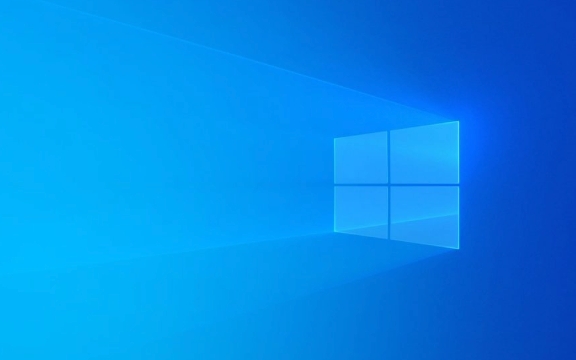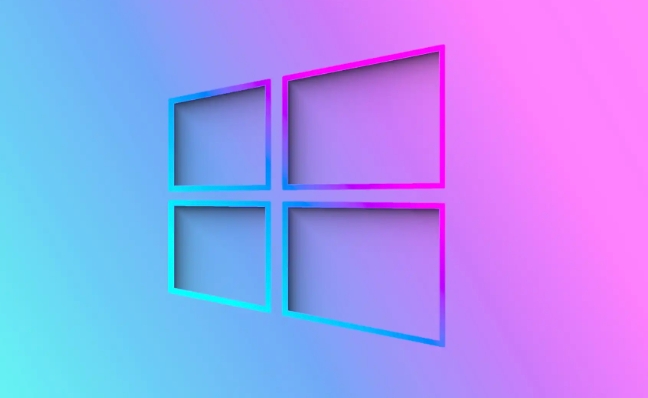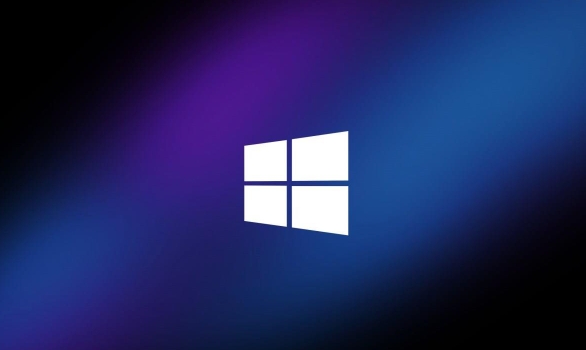Virtual memory is a mechanism for Windows to expand physical memory, and reasonable settings can improve performance. When physical memory is insufficient, the system moves infrequently used data to the hard disk, freeing up space for the current task. Ordinary users can rely on Windows to automatically manage, but manual adjustment is more appropriate if you run large software, use old machines, or encounter insufficient memory prompts. The steps to view and modify are: Win R input sysdm.cpl → "Advanced" page → "Performance Settings" → "Virtual Memory Changes" → Cancel automatic management → Select "Custom Size". Users can set the initial 4096MB and the maximum 12288MB for 8GB memory; the recommended virtual memory is 1.5~2 times; and above 16GB can set the initial 4GB memory to 1~1.5 times. Virtual memory should not be turned off at will, otherwise the program may crash unless the consequences are clearly understood and tested correctly.

Windows' virtual memory management is actually not that complicated, but if you don't use it well, it will affect the computer's running efficiency. Simply put, the system will use part of the hard disk space as memory. When there is insufficient physical memory, it will use this part of "virtual memory" to relieve stress. If you often run multiple programs, large software or play games, setting up virtual memory reasonably can bring some performance improvements.

Here are some common adjustment directions and suggestions:
What is virtual memory? Why do adjustments need to be made?
Virtual memory is a mechanism used by Windows to extend physical memory (RAM). When you run too many programs and cannot load physical memory, the system will temporarily place some of the infrequently used data on the hard disk to free up space for running tasks.

By default, Windows automatically manages virtual memory, and most ordinary users do not actually need to move it. However, for some situations, such as programs that require large memory, old machines upgrade SSDs, or encountering "out of memory", manual settings may be more appropriate.
How to view and modify virtual memory settings?
To adjust virtual memory, you can follow these steps:

- Press
Win Rto open the run window, entersysdm.cpl, and press Enter. - Switch to the Advanced tab and click Settings in the Performance section.
- Switch to the Advanced tab again and click the Change button in Virtual Memory.
- Uncheck "Automatically manage paging file sizes for all drives".
- Select the system disk and you can select Custom Size or No Paging File.
Generally speaking, "custom size" is suitable for users with specific needs, while "system-managed size" is enough for most people.
What size of virtual memory is more appropriate?
There is no fixed answer to this, but you can roughly judge based on your usage scenario:
- If you have 8GB or more memory, you can work on your daily basis, surf the Internet, watch videos, and keep the default settings.
- If you have 16GB or more memory and often run large software (such as Photoshop, Premiere, CAD), you can appropriately increase the virtual memory limit, such as setting it to 1~1.5 times of physical memory.
- If you only have 4GB of memory, virtual memory is even more important. It is recommended to set it to at least 1.5~2 times the physical memory.
For example: You have 8GB of memory, you can set the initial size to 4096MB and the maximum value to about 12288MB, which can basically meet most needs.
Note: Do not set the virtual memory too small, otherwise there will be insufficient memory errors; do not set it too large, not to waste hard disk space, it may also affect performance.
Should virtual memory be disabled?
Some people on the Internet say, "My memory is large enough, it is faster to turn off the virtual memory directly", which is actually a misunderstanding.
Even if you have 32GB or more memory, some programs rely on virtual memory mechanisms to run properly. After closing, some applications may crash or report an error.
Unless you are very clear about what you are doing and have tested and confirmed that there is no problem, it is not recommended to turn off virtual memory .
Basically that's it. Setting up virtual memory is not a high-tech operation, and it does not require daily adjustments. As long as you make appropriate adjustments based on your own hardware configuration and usage habits, the system can run more stably.
The above is the detailed content of How to manage virtual memory in Windows. For more information, please follow other related articles on the PHP Chinese website!

Hot AI Tools

Undress AI Tool
Undress images for free

Undresser.AI Undress
AI-powered app for creating realistic nude photos

AI Clothes Remover
Online AI tool for removing clothes from photos.

Clothoff.io
AI clothes remover

Video Face Swap
Swap faces in any video effortlessly with our completely free AI face swap tool!

Hot Article

Hot Tools

Notepad++7.3.1
Easy-to-use and free code editor

SublimeText3 Chinese version
Chinese version, very easy to use

Zend Studio 13.0.1
Powerful PHP integrated development environment

Dreamweaver CS6
Visual web development tools

SublimeText3 Mac version
God-level code editing software (SublimeText3)

Hot Topics
 How to remove password from Windows 11 login
Jun 27, 2025 am 01:38 AM
How to remove password from Windows 11 login
Jun 27, 2025 am 01:38 AM
If you want to cancel the password login for Windows 11, there are three methods to choose: 1. Modify the automatic login settings, uncheck "To use this computer, users must enter their username and password", and then restart the automatic login after entering the password; 2. Switch to a passwordless login method, such as PIN, fingerprint or face recognition, configure it in "Settings>Account>Login Options" to improve convenience and security; 3. Delete the account password directly, but there are security risks and may lead to some functions being limited. It is recommended to choose a suitable solution based on actual needs.
 I Became a Windows Power User Overnight With This New Open-Source App from Microsoft
Jun 20, 2025 am 06:07 AM
I Became a Windows Power User Overnight With This New Open-Source App from Microsoft
Jun 20, 2025 am 06:07 AM
Like many Windows users, I am always on the lookout for ways to boost my productivity. Command Palette quickly became an essential tool for me. This powerful utility has completely changed how I interact with Windows, giving me instant access to the
 How to uninstall programs in Windows 11?
Jun 30, 2025 am 12:41 AM
How to uninstall programs in Windows 11?
Jun 30, 2025 am 12:41 AM
There are three main ways to uninstall programs on Windows 11: 1. Uninstall through "Settings", open the "Settings" > "Apps" > "Installed Applications", select the program and click "Uninstall", which is suitable for most users; 2. Use the control panel, search and enter "Control Panel" > "Programs and Functions", right-click the program and select "Uninstall", which is suitable for users who are accustomed to traditional interfaces; 3. Use third-party tools such as RevoUninstaller to clean up more thoroughly, but pay attention to the download source and operation risks, and novices can give priority to using the system's own methods.
 How to run an app as an administrator in Windows?
Jul 01, 2025 am 01:05 AM
How to run an app as an administrator in Windows?
Jul 01, 2025 am 01:05 AM
To run programs as administrator, you can use Windows' own functions: 1. Right-click the menu to select "Run as administrator", which is suitable for temporary privilege hike scenarios; 2. Create a shortcut and check "Run as administrator" to achieve automatic privilege hike start; 3. Use the task scheduler to configure automated tasks, suitable for running programs that require permissions on a scheduled or background basis, pay attention to setting details such as path changes and permission checks.
 Windows 10 KB5061087 fixes Start menu crash, direct download links
Jun 26, 2025 pm 04:22 PM
Windows 10 KB5061087 fixes Start menu crash, direct download links
Jun 26, 2025 pm 04:22 PM
Windows 10 KB5061087 is now rolling out as an optional preview update for those on version 22H2 with Start menu fixes.
 Windows 11 Is Bringing Back Another Windows 10 Feature
Jun 18, 2025 am 01:27 AM
Windows 11 Is Bringing Back Another Windows 10 Feature
Jun 18, 2025 am 01:27 AM
This might not be at the top of the list of features people want to return from Windows 10, but it still offers some usefulness. If you'd like to view the current minutes and seconds without turning on that display in the main taskbar clock (where it
 Microsoft: DHCP issue hits KB5060526, KB5060531 of Windows Server
Jun 26, 2025 pm 04:32 PM
Microsoft: DHCP issue hits KB5060526, KB5060531 of Windows Server
Jun 26, 2025 pm 04:32 PM
Microsoft confirmed that the DHCP server service might stop responding or refuse to connect after the June 2025 Update for Windows Server.
 Building Your First Gaming PC in 2025: What You Actually Need
Jun 24, 2025 am 12:52 AM
Building Your First Gaming PC in 2025: What You Actually Need
Jun 24, 2025 am 12:52 AM
In the past, I always viewed the i5 lineup as anemic when it came to gaming. However, in 2025, a mid-range CPU is more than enough to start your gaming journey. Many games still don’t fully utilize multi-core performance as well as they could, so






